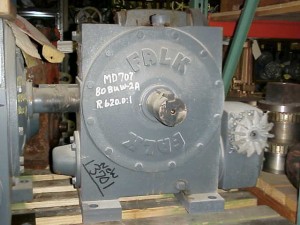 Choosing the proper gear is an art that isn’t easily translated into a formula for success. Designers and engineers often select a certain Falk gear reducer or Falk gearbox only after experimenting with a couple of different gear setup options. Furthermore, cost concerns may cause designers to select only gears that are available through Falk surplus or other discount programs.
Choosing the proper gear is an art that isn’t easily translated into a formula for success. Designers and engineers often select a certain Falk gear reducer or Falk gearbox only after experimenting with a couple of different gear setup options. Furthermore, cost concerns may cause designers to select only gears that are available through Falk surplus or other discount programs.
Still, there are a few general questions one can ask to aid in selecting the proper gear for an industrial application. Read on to discover the questions master designers and engineers ask themselves to find the best Falk gearbox or gear reducer setup for the system at hand.
What is the shape of the apparatus that needs a gear drive?
Selecting the gears in a Falk gearbox may be as simple as examining what the surrounding system requires. For instance, some gear systems must be installed on parallel axes. If this is the case, helical or spur gears work well. For gear systems that are placed at right angles, worm and bevel gears are compatible. Sometimes, axes are non-parallel and nonintersecting – hypoid gears, worm gears, spiroid gears, and cross-helical gears are best for such situations. (Generally, worm gears are only used when the axes are at right angles.)
What is the speed of the system where the gearbox will be used? What is the horsepower?
For slower systems with lower horsepower requirements, designers have many options for Falk gearbox setups. However, not all gears can manage high-speed, high-horsepower situations. External helical gears are the best choice for these requirements. Indeed, external helical gears have been used to handle as much as 45,000 kilowatts of power on a single gear and pinion. On the other end of the spectrum, spur gears are often used in low-speed systems. (We should mention that spur gears are popular with many designers because they are simple in design.)
What efficiency must the drive have?
Bevel and hypoid gears are excellent gear choices when high efficiency is required. When placed in right-angle drive setups, these gears can be as much as 98 percent efficient. (Some energy is naturally lost to friction and heat in any Falk gear reducer or gearbox.)
Is a Falk gear reducer or other reducing mechanism needed?
Gear reducers use the wonder of ratios to reduce the speed at which a system runs. Pairing a very small gear with a very large gear, for instance, slows down the output because the smaller gear must turn many times in the same amount of time that it takes the larger gear to turn once.
Space is often limited in industrial settings, so gear reduction must be accomplished quickly while taking up very little volume. Worm gears are an excellent choice for such situations. They can quickly, efficiently reduce speed.
What kind of budget is available for the gear drive system?
As in every well-run business, engineers must counterbalance their design dreams with costs. Since they are usually less expensive, Falk surplus gears, gear reducers and gearboxes can help designers meet their budgets while selecting mechanically viable parts.
Are there any noise limits on this application?
Gear drive systems can be extraordinarily loud. When selecting a gear, think about how noise will affect the working environment. For instance, if employees must work near this gear drive for most of the day, a deafening gear drive is likely to cause hearing loss (and work injury claims). As Falk gearbox experts will tell you, some gears are quieter than others.
There are many techniques for reducing gear noise; one approach is to increase the contact ratio between meshed gears. Depending on their shape, different types of gears offer a higher contact ratio. For instance, a spiral bevel gear will be quieter than a straight bevel gear, since the spiral design makes for more contact area between gears. Along the same lines, helical gears are quieter than spur gears.
Who will conduct repairs to the system?
One final consideration is how the entire gear drive will be repaired if something goes wrong. (And as any power plant manager or mining operations lead can tell you, if something can go wrong in your gear drive system, it will go wrong eventually.) When selecting gears, remember that some manufacturers offer warranties; for instance, under the Falk Renew system, Falk gear reducers and Falk surplus parts usually carry a one-year warranty.
The above questions cover some of the issues engineers and designers must consider when selecting gear systems.
Posted under Tips and Tricks on Tuesday, September 27th, 2011
